No products in the basket.
112 items found
Page 1 of 2
-

Two large Tiffany style stained glass panels,
£7,500 the pairTwo large Tiffany style stained glass panels,
depicting a pastoral scene, framed. En suite with stock #77885£7,500 the pair -

Continental School, floral still-life
£3,200Continental School, floral still-life
Continental still-life of a vase of flowers on a stone ledge. Gilt Frame. Old repairs and slight loss on paint.£3,200 -

Still-life of Flowers
£290 -

An Eighteenth Century Chinese Vase, Kangxi period.
£200An Eighteenth Century Chinese Vase, Kangxi period.
Having a flared wide rim with painted flower design, leading to slender body decorated with flower and leaf designs above stylised garden pagoda scene on a stepped base. Minor chips to the rim.£200 -

Linden Botanicals
£175 eachLinden Botanicals
L’Illustration Horticole, was a monthly horticultural review, founded in 1854 in Ghent, Belgium, by Ambroise Verschaffelt, a nurseryman who specialised in new plant introductions from South America. The lavish illustrations were produced by some of the very best botanical artists and lithographers – A. Goosens, P. De Pannemaeker and J. Goffart. The L’Illustration Horticole although founded by Jean Jules Linden (1817 – 1898) became a collaborative effort of many great horticulturists and field botanists of the day. Jean Linden in his own right was a renowned orchid grower and collector. Each monthly edition featured chromolithograph of botanical prints. Plants such as orchids, camellias, roses and leafy plants such as ferns and palm trees were represented. The magazine’s scope included pictures, descriptions, the history and culture of “the most remarkable plants,” new introductions, horticultural history, botanical expeditions, and accounts of the major expositions and of new works on botany and horticulture as well as garden descriptions and layouts.£175 each -

Linden Botanicals,
£175 eachLinden Botanicals,
L’Illustration Horticole, was a monthly horticultural review, founded in 1854 in Ghent, Belgium, by Ambroise Verschaffelt, a nurseryman who specialised in new plant introductions from South America. The lavish illustrations were produced by some of the very best botanical artists and lithographers – A. Goosens, P. De Pannemaeker and J. Goffart. The L’Illustration Horticole although founded by Jean Jules Linden (1817 – 1898) became a collaborative effort of many great horticulturists and field botanists of the day. Jean Linden in his own right was a renowned orchid grower and collector. Each monthly edition featured chromolithograph of botanical prints. Plants such as orchids, camellias, roses and leafy plants such as ferns and palm trees were represented. The magazine’s scope included pictures, descriptions, the history and culture of “the most remarkable plants,” new introductions, horticultural history, botanical expeditions, and accounts of the major expositions and of new works on botany and horticulture as well as garden descriptions and layouts.£175 each -

Linden Botanicals
£175 eachLinden Botanicals
L’Illustration Horticole, was a monthly horticultural review, founded in 1854 in Ghent, Belgium, by Ambroise Verschaffelt, a nurseryman who specialised in new plant introductions from South America. The lavish illustrations were produced by some of the very best botanical artists and lithographers – A. Goosens, P. De Pannemaeker and J. Goffart. The L’Illustration Horticole although founded by Jean Jules Linden (1817 – 1898) became a collaborative effort of many great horticulturists and field botanists of the day. Jean Linden in his own right was a renowned orchid grower and collector. Each monthly edition featured chromolithograph of botanical prints. Plants such as orchids, camellias, roses and leafy plants such as ferns and palm trees were represented. The magazine’s scope included pictures, descriptions, the history and culture of “the most remarkable plants,” new introductions, horticultural history, botanical expeditions, and accounts of the major expositions and of new works on botany and horticulture as well as garden descriptions and layouts.£175 each -

Linden Botanicals
£175 eachLinden Botanicals
L’Illustration Horticole, was a monthly horticultural review, founded in 1854 in Ghent, Belgium, by Ambroise Verschaffelt, a nurseryman who specialised in new plant introductions from South America. The lavish illustrations were produced by some of the very best botanical artists and lithographers – A. Goosens, P. De Pannemaeker and J. Goffart. The L’Illustration Horticole although founded by Jean Jules Linden (1817 – 1898) became a collaborative effort of many great horticulturists and field botanists of the day. Jean Linden in his own right was a renowned orchid grower and collector. Each monthly edition featured chromolithograph of botanical prints. Plants such as orchids, camellias, roses and leafy plants such as ferns and palm trees were represented. The magazine’s scope included pictures, descriptions, the history and culture of “the most remarkable plants,” new introductions, horticultural history, botanical expeditions, and accounts of the major expositions and of new works on botany and horticulture as well as garden descriptions and layouts.£175 each -
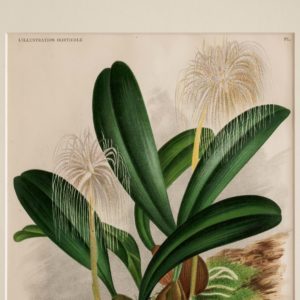
Linden Botanicals
£175 eachLinden Botanicals
L’Illustration Horticole, was a monthly horticultural review, founded in 1854 in Ghent, Belgium, by Ambroise Verschaffelt, a nurseryman who specialised in new plant introductions from South America. The lavish illustrations were produced by some of the very best botanical artists and lithographers – A. Goosens, P. De Pannemaeker and J. Goffart. The L’Illustration Horticole although founded by Jean Jules Linden (1817 – 1898) became a collaborative effort of many great horticulturists and field botanists of the day. Jean Linden in his own right was a renowned orchid grower and collector. Each monthly edition featured chromolithograph of botanical prints. Plants such as orchids, camellias, roses and leafy plants such as ferns and palm trees were represented. The magazine’s scope included pictures, descriptions, the history and culture of “the most remarkable plants,” new introductions, horticultural history, botanical expeditions, and accounts of the major expositions and of new works on botany and horticulture as well as garden descriptions and layouts.£175 each -

Linden Botanicals
£175 eachLinden Botanicals
L’Illustration Horticole, was a monthly horticultural review, founded in 1854 in Ghent, Belgium, by Ambroise Verschaffelt, a nurseryman who specialised in new plant introductions from South America. The lavish illustrations were produced by some of the very best botanical artists and lithographers – A. Goosens, P. De Pannemaeker and J. Goffart. The L’Illustration Horticole although founded by Jean Jules Linden (1817 – 1898) became a collaborative effort of many great horticulturists and field botanists of the day. Jean Linden in his own right was a renowned orchid grower and collector. Each monthly edition featured chromolithograph of botanical prints. Plants such as orchids, camellias, roses and leafy plants such as ferns and palm trees were represented. The magazine’s scope included pictures, descriptions, the history and culture of “the most remarkable plants,” new introductions, horticultural history, botanical expeditions, and accounts of the major expositions and of new works on botany and horticulture as well as garden descriptions and layouts.£175 each -

Linden Botanicals
£175 eachLinden Botanicals
L’Illustration Horticole, was a monthly horticultural review, founded in 1854 in Ghent, Belgium, by Ambroise Verschaffelt, a nurseryman who specialised in new plant introductions from South America. The lavish illustrations were produced by some of the very best botanical artists and lithographers – A. Goosens, P. De Pannemaeker and J. Goffart. The L’Illustration Horticole although founded by Jean Jules Linden (1817 – 1898) became a collaborative effort of many great horticulturists and field botanists of the day. Jean Linden in his own right was a renowned orchid grower and collector. Each monthly edition featured chromolithograph of botanical prints. Plants such as orchids, camellias, roses and leafy plants such as ferns and palm trees were represented. The magazine’s scope included pictures, descriptions, the history and culture of “the most remarkable plants,” new introductions, horticultural history, botanical expeditions, and accounts of the major expositions and of new works on botany and horticulture as well as garden descriptions and layouts.£175 each -

Linden Botanicals
£175 eachLinden Botanicals
L’Illustration Horticole, was a monthly horticultural review, founded in 1854 in Ghent, Belgium, by Ambroise Verschaffelt, a nurseryman who specialised in new plant introductions from South America. The lavish illustrations were produced by some of the very best botanical artists and lithographers – A. Goosens, P. De Pannemaeker and J. Goffart. The L’Illustration Horticole although founded by Jean Jules Linden (1817 – 1898) became a collaborative effort of many great horticulturists and field botanists of the day. Jean Linden in his own right was a renowned orchid grower and collector. Each monthly edition featured chromolithograph of botanical prints. Plants such as orchids, camellias, roses and leafy plants such as ferns and palm trees were represented. The magazine’s scope included pictures, descriptions, the history and culture of “the most remarkable plants,” new introductions, horticultural history, botanical expeditions, and accounts of the major expositions and of new works on botany and horticulture as well as garden descriptions and layouts.£175 each -

Linden Botanicals
£175 eachLinden Botanicals
L’Illustration Horticole, was a monthly horticultural review, founded in 1854 in Ghent, Belgium, by Ambroise Verschaffelt, a nurseryman who specialised in new plant introductions from South America. The lavish illustrations were produced by some of the very best botanical artists and lithographers – A. Goosens, P. De Pannemaeker and J. Goffart. The L’Illustration Horticole although founded by Jean Jules Linden (1817 – 1898) became a collaborative effort of many great horticulturists and field botanists of the day. Jean Linden in his own right was a renowned orchid grower and collector. Each monthly edition featured chromolithograph of botanical prints. Plants such as orchids, camellias, roses and leafy plants such as ferns and palm trees were represented. The magazine’s scope included pictures, descriptions, the history and culture of “the most remarkable plants,” new introductions, horticultural history, botanical expeditions, and accounts of the major expositions and of new works on botany and horticulture as well as garden descriptions and layouts.£175 each -

Curtis’s Botanical Lithographs,
£140 eachCurtis’s Botanical Lithographs,
Printed by L. Reeve and Co. of Covent Garden. Framed in natural oak.£140 each -

Curtis’s Botanical Lithographs,
£140 eachCurtis’s Botanical Lithographs,
Printed by L. Reeve and Co. of Covent Garden. Framed in natural oak.£140 each -

Curtis’s Botanical Lithographs,
£140 eachCurtis’s Botanical Lithographs,
Printed by L. Reeve and Co. of Covent Garden. Framed in natural oak.£140 each -

Curtis’s Botanical Lithographs,
£140 eachCurtis’s Botanical Lithographs,
Printed by L. Reeve and Co. of Covent Garden. Framed in natural oak.£140 each -

Curtis’s Botanical Lithographs,
£140 eachCurtis’s Botanical Lithographs,
Printed by L. Reeve and Co. of Covent Garden. Framed in natural oak.£140 each -

Curtis’s Botanical Lithographs,
£140 eachCurtis’s Botanical Lithographs,
Printed by L. Reeve and Co. of Covent Garden. Framed in natural oak.£140 each -

Curtis’s Botanical Lithographs,
£140 eachCurtis’s Botanical Lithographs,
Printed by L. Reeve and Co. of Covent Garden. Framed in natural oak.£140 each -

Curtis’s Botanical Lithographs,
£140 eachCurtis’s Botanical Lithographs,
Printed by L. Reeve and Co. of Covent Garden. Framed in natural oak.£140 each -

Curtis’s Botanical Lithographs,
£140 eachCurtis’s Botanical Lithographs,
Printed by L. Reeve and Co. of Covent Garden. Framed in natural oak.£140 each -

Curtis’s Botanical Lithographs,
£140 eachCurtis’s Botanical Lithographs,
Printed by L. Reeve and Co. of Covent Garden. Framed in natural oak.£140 each -

Curtis’s Botanical Lithographs,
£140 eachCurtis’s Botanical Lithographs,
Printed by L. Reeve and Co. of Covent Garden. Framed in natural oak.£140 each -

Curtis’s Botanical Lithographs,
£140 eachCurtis’s Botanical Lithographs,
Printed by L. Reeve and Co. of Covent Garden. Framed in natural oak.£140 each -

Curtis’s Botanical Lithographs,
£140 eachCurtis’s Botanical Lithographs,
Printed by L. Reeve and Co. of Covent Garden. Framed in natural oak.£140 each -

Curtis’s Botanical Lithographs,
£140 eachCurtis’s Botanical Lithographs,
Printed by L. Reeve and Co. of Covent Garden. Framed in natural oak.£140 each -

Curtis’s Botanical Lithographs,
£140 eachCurtis’s Botanical Lithographs,
Printed by L. Reeve and Co. of Covent Garden. Framed in natural oak.£140 each -
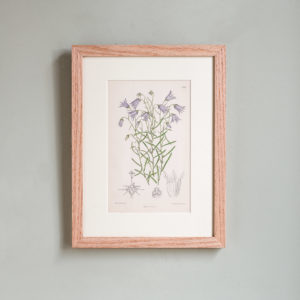
Curtis’s Botanical Lithographs,
£140 eachCurtis’s Botanical Lithographs,
Printed by L. Reeve and Co. of Covent Garden. Framed in natural oak.£140 each -

Curtis’s Botanical Lithographs,
£140 eachCurtis’s Botanical Lithographs,
Printed by L. Reeve and Co. of Covent Garden. Framed in natural oak.£140 each -

Curtis’s Botanical Lithographs,
£140 eachCurtis’s Botanical Lithographs,
Printed by L. Reeve and Co. of Covent Garden. Framed in natural oak.£140 each -

Curtis’s Botanical Lithographs,
£140 eachCurtis’s Botanical Lithographs,
Printed by L. Reeve and Co. of Covent Garden. Framed in natural oak.£140 each -
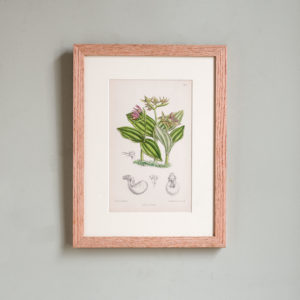
Curtis’s Botanical Lithographs,
£140 eachCurtis’s Botanical Lithographs,
Printed by L. Reeve and Co. of Covent Garden. Framed in natural oak.£140 each -

A Small Blue and White transfer printed gold fish bowl.
£120A Small Blue and White transfer printed gold fish bowl.
The late nineteenth century European made porcelain bowl, produced to mimic a Chinese gold fish bowl. The wide rim designed to stop fish escaping, is decorated with blue flower heads, above a bulbous body decorated with layered flower designs. The mark on the base in the form of a simple windmill could indicate the piece was produced in Holland.£120 -

19th century Lepidoptera prints,
£120 -

19th century Lepidoptera prints,
£120 -

19th century Lepidoptera prints,
£120 -
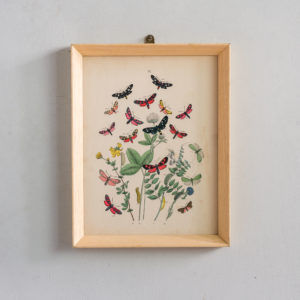
19th century Lepidoptera prints,
£120 -

19th century Lepidoptera prints,
£120 -

19th century Lepidoptera prints,
£120 -

19th century Lepidoptera prints,
£120 -

19th century Lepidoptera prints,
£120 -

19th century Lepidoptera prints,
£120 -

19th century Lepidoptera prints,
£120 -

19th century Lepidoptera prints,
£120 -

19th century Lepidoptera prints,
£120 -

19th century Lepidoptera prints,
£120 -
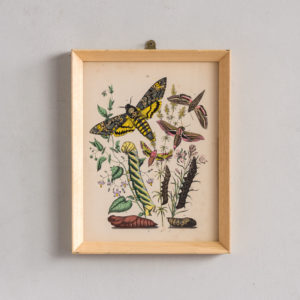
19th century Lepidoptera prints,
£120 -

19th century Lepidoptera prints,
£120 -

Alpine Flowers
£110 eachAlpine Flowers
Anton Hartinger was an Austrian artist who specialized in still life paintings of fruit and flowers. He was born in Vienna in 1806 and a member of the Academy of Fine Arts Vienna from 1843 to 1851. He later became a pioneer in the field of chromolithographic printing. He died in Vienna in 1890.£110 each -

Alpine Flowers
£110 eachAlpine Flowers
Anton Hartinger was an Austrian artist who specialized in still life paintings of fruit and flowers. He was born in Vienna in 1806 and a member of the Academy of Fine Arts Vienna from 1843 to 1851. He later became a pioneer in the field of chromolithographic printing. He died in Vienna in 1890.£110 each -

Alpine Flowers
£110 eachAlpine Flowers
Anton Hartinger was an Austrian artist who specialized in still life paintings of fruit and flowers. He was born in Vienna in 1806 and a member of the Academy of Fine Arts Vienna from 1843 to 1851. He later became a pioneer in the field of chromolithographic printing. He died in Vienna in 1890.£110 each -

Alpine Flowers
£110 eachAlpine Flowers
Anton Hartinger was an Austrian artist who specialized in still life paintings of fruit and flowers. He was born in Vienna in 1806 and a member of the Academy of Fine Arts Vienna from 1843 to 1851. He later became a pioneer in the field of chromolithographic printing. He died in Vienna in 1890.£110 each -

Alpine Flowers
£110 eachAlpine Flowers
Anton Hartinger was an Austrian artist who specialized in still life paintings of fruit and flowers. He was born in Vienna in 1806 and a member of the Academy of Fine Arts Vienna from 1843 to 1851. He later became a pioneer in the field of chromolithographic printing. He died in Vienna in 1890.£110 each -

Alpine Flowers
£110 eachAlpine Flowers
Anton Hartinger was an Austrian artist who specialized in still life paintings of fruit and flowers. He was born in Vienna in 1806 and a member of the Academy of Fine Arts Vienna from 1843 to 1851. He later became a pioneer in the field of chromolithographic printing. He died in Vienna in 1890.£110 each -

Alpine Flowers
£110 eachAlpine Flowers
Anton Hartinger was an Austrian artist who specialized in still life paintings of fruit and flowers. He was born in Vienna in 1806 and a member of the Academy of Fine Arts Vienna from 1843 to 1851. He later became a pioneer in the field of chromolithographic printing. He died in Vienna in 1890.£110 each -

Alpine Flowers
£110 eachAlpine Flowers
Anton Hartinger was an Austrian artist who specialized in still life paintings of fruit and flowers. He was born in Vienna in 1806 and a member of the Academy of Fine Arts Vienna from 1843 to 1851. He later became a pioneer in the field of chromolithographic printing. He died in Vienna in 1890.£110 each -

Alpine Flowers
£110 eachAlpine Flowers
Anton Hartinger was an Austrian artist who specialized in still life paintings of fruit and flowers. He was born in Vienna in 1806 and a member of the Academy of Fine Arts Vienna from 1843 to 1851. He later became a pioneer in the field of chromolithographic printing. He died in Vienna in 1890.£110 each -
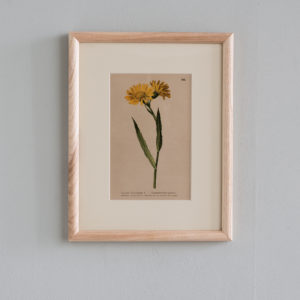
Alpine Flowers
£110 eachAlpine Flowers
Anton Hartinger was an Austrian artist who specialized in still life paintings of fruit and flowers. He was born in Vienna in 1806 and a member of the Academy of Fine Arts Vienna from 1843 to 1851. He later became a pioneer in the field of chromolithographic printing. He died in Vienna in 1890.£110 each -

Alpine Flowers
£110 eachAlpine Flowers
Anton Hartinger was an Austrian artist who specialized in still life paintings of fruit and flowers. He was born in Vienna in 1806 and a member of the Academy of Fine Arts Vienna from 1843 to 1851. He later became a pioneer in the field of chromolithographic printing. He died in Vienna in 1890.£110 each -

Alpine Flowers
£110 eachAlpine Flowers
Anton Hartinger was an Austrian artist who specialized in still life paintings of fruit and flowers. He was born in Vienna in 1806 and a member of the Academy of Fine Arts Vienna from 1843 to 1851. He later became a pioneer in the field of chromolithographic printing. He died in Vienna in 1890.£110 each -

Alpine Flowers
£110 eachAlpine Flowers
Anton Hartinger was an Austrian artist who specialized in still life paintings of fruit and flowers. He was born in Vienna in 1806 and a member of the Academy of Fine Arts Vienna from 1843 to 1851. He later became a pioneer in the field of chromolithographic printing. He died in Vienna in 1890.£110 each -

Alpine Flowers
£110 eachAlpine Flowers
Anton Hartinger was an Austrian artist who specialized in still life paintings of fruit and flowers. He was born in Vienna in 1806 and a member of the Academy of Fine Arts Vienna from 1843 to 1851. He later became a pioneer in the field of chromolithographic printing. He died in Vienna in 1890.£110 each -

Alpine Flowers
£110 eachAlpine Flowers
Anton Hartinger was an Austrian artist who specialized in still life paintings of fruit and flowers. He was born in Vienna in 1806 and a member of the Academy of Fine Arts Vienna from 1843 to 1851. He later became a pioneer in the field of chromolithographic printing. He died in Vienna in 1890.£110 each -

Alpine Flowers
£110 eachAlpine Flowers
Anton Hartinger was an Austrian artist who specialized in still life paintings of fruit and flowers. He was born in Vienna in 1806 and a member of the Academy of Fine Arts Vienna from 1843 to 1851. He later became a pioneer in the field of chromolithographic printing. He died in Vienna in 1890.£110 each -

Alpine Flowers
£110 eachAlpine Flowers
Anton Hartinger was an Austrian artist who specialized in still life paintings of fruit and flowers. He was born in Vienna in 1806 and a member of the Academy of Fine Arts Vienna from 1843 to 1851. He later became a pioneer in the field of chromolithographic printing. He died in Vienna in 1890.£110 each -
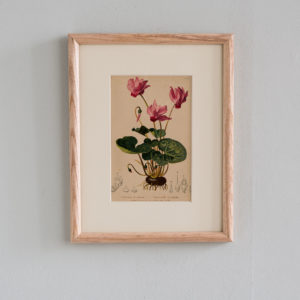
Alpine Flowers
£110 eachAlpine Flowers
Anton Hartinger was an Austrian artist who specialized in still life paintings of fruit and flowers. He was born in Vienna in 1806 and a member of the Academy of Fine Arts Vienna from 1843 to 1851. He later became a pioneer in the field of chromolithographic printing. He died in Vienna in 1890.£110 each -

Alpine Flowers
£110 eachAlpine Flowers
Anton Hartinger was an Austrian artist who specialized in still life paintings of fruit and flowers. He was born in Vienna in 1806 and a member of the Academy of Fine Arts Vienna from 1843 to 1851. He later became a pioneer in the field of chromolithographic printing. He died in Vienna in 1890.£110 each -

Alpine Flowers
£110 eachAlpine Flowers
Anton Hartinger was an Austrian artist who specialized in still life paintings of fruit and flowers. He was born in Vienna in 1806 and a member of the Academy of Fine Arts Vienna from 1843 to 1851. He later became a pioneer in the field of chromolithographic printing. He died in Vienna in 1890.£110 each -
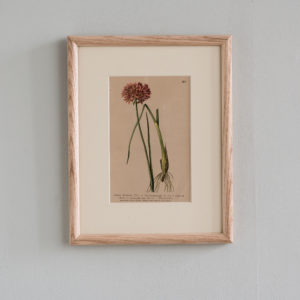
Alpine Flowers
£110 eachAlpine Flowers
Anton Hartinger was an Austrian artist who specialized in still life paintings of fruit and flowers. He was born in Vienna in 1806 and a member of the Academy of Fine Arts Vienna from 1843 to 1851. He later became a pioneer in the field of chromolithographic printing. He died in Vienna in 1890.£110 each -

Alpine Flowers
£110 eachAlpine Flowers
Anton Hartinger was an Austrian artist who specialized in still life paintings of fruit and flowers. He was born in Vienna in 1806 and a member of the Academy of Fine Arts Vienna from 1843 to 1851. He later became a pioneer in the field of chromolithographic printing. He died in Vienna in 1890.£110 each -
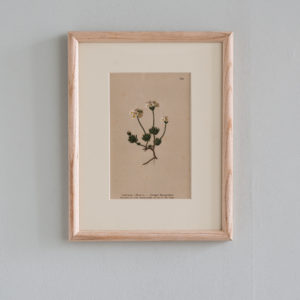
Alpine Flowers
£110 eachAlpine Flowers
Anton Hartinger was an Austrian artist who specialized in still life paintings of fruit and flowers. He was born in Vienna in 1806 and a member of the Academy of Fine Arts Vienna from 1843 to 1851. He later became a pioneer in the field of chromolithographic printing. He died in Vienna in 1890.£110 each -

Sertum Orchidaceum by John Lindley 1838
£95 eachSertum Orchidaceum by John Lindley 1838
Spectacular large-scale prints of the most beautiful known Orchids selected, selected by John Lindley, perhaps the greatest early orchidologist, drawn by Sarah Anne Drake and lithographed by Maxime Gauci. Although John Lindley is now known as a botanist of wide accomplishments, the study of orchids had been an area of special interest to him from early in his career when he was employed by the orchid specialist William Cattley.£95 each -

Sertum Orchidaceum by John Lindley 1838
£95 eachSertum Orchidaceum by John Lindley 1838
Spectacular large-scale prints of the most beautiful known Orchids selected, selected by John Lindley, perhaps the greatest early orchidologist, drawn by Sarah Anne Drake and lithographed by Maxime Gauci. Although John Lindley is now known as a botanist of wide accomplishments, the study of orchids had been an area of special interest to him from early in his career when he was employed by the orchid specialist William Cattley.£95 each -

Sertum Orchidaceum by John Lindley 1838
£95 eachSertum Orchidaceum by John Lindley 1838
Spectacular large-scale prints of the most beautiful known Orchids selected, selected by John Lindley, perhaps the greatest early orchidologist, drawn by Sarah Anne Drake and lithographed by Maxime Gauci. Although John Lindley is now known as a botanist of wide accomplishments, the study of orchids had been an area of special interest to him from early in his career when he was employed by the orchid specialist William Cattley.£95 each -
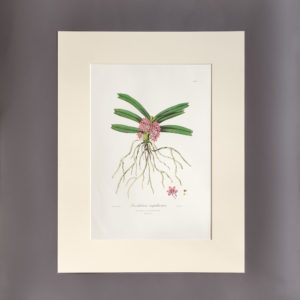
Sertum Orchidaceum by John Lindley 1838
£95 eachSertum Orchidaceum by John Lindley 1838
Spectacular large-scale prints of the most beautiful known Orchids selected, selected by John Lindley, perhaps the greatest early orchidologist, drawn by Sarah Anne Drake and lithographed by Maxime Gauci. Although John Lindley is now known as a botanist of wide accomplishments, the study of orchids had been an area of special interest to him from early in his career when he was employed by the orchid specialist William Cattley.£95 each -

Sertum Orchidaceum by John Lindley 1838
£95 eachSertum Orchidaceum by John Lindley 1838
Spectacular large-scale prints of the most beautiful known Orchids selected, selected by John Lindley, perhaps the greatest early orchidologist, drawn by Sarah Anne Drake and lithographed by Maxime Gauci. Although John Lindley is now known as a botanist of wide accomplishments, the study of orchids had been an area of special interest to him from early in his career when he was employed by the orchid specialist William Cattley.£95 each -

Sertum Orchidaceum by John Lindley 1838
£95 eachSertum Orchidaceum by John Lindley 1838
Spectacular large-scale prints of the most beautiful known Orchids selected, selected by John Lindley, perhaps the greatest early orchidologist, drawn by Sarah Anne Drake and lithographed by Maxime Gauci. Although John Lindley is now known as a botanist of wide accomplishments, the study of orchids had been an area of special interest to him from early in his career when he was employed by the orchid specialist William Cattley.£95 each -

Sertum Orchidaceum by John Lindley 1838
£95 eachSertum Orchidaceum by John Lindley 1838
Spectacular large-scale prints of the most beautiful known Orchids selected, selected by John Lindley, perhaps the greatest early orchidologist, drawn by Sarah Anne Drake and lithographed by Maxime Gauci. Although John Lindley is now known as a botanist of wide accomplishments, the study of orchids had been an area of special interest to him from early in his career when he was employed by the orchid specialist William Cattley.£95 each -
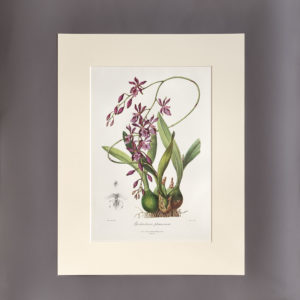
Sertum Orchidaceum by John Lindley 1838
£95 eachSertum Orchidaceum by John Lindley 1838
Spectacular large-scale prints of the most beautiful known Orchids selected, selected by John Lindley, perhaps the greatest early orchidologist, drawn by Sarah Anne Drake and lithographed by Maxime Gauci. Although John Lindley is now known as a botanist of wide accomplishments, the study of orchids had been an area of special interest to him from early in his career when he was employed by the orchid specialist William Cattley.£95 each -

Sertum Orchidaceum by John Lindley 1838
£95 eachSertum Orchidaceum by John Lindley 1838
Spectacular large-scale prints of the most beautiful known Orchids selected, selected by John Lindley, perhaps the greatest early orchidologist, drawn by Sarah Anne Drake and lithographed by Maxime Gauci. Although John Lindley is now known as a botanist of wide accomplishments, the study of orchids had been an area of special interest to him from early in his career when he was employed by the orchid specialist William Cattley.£95 each -

Sertum Orchidaceum by John Lindley 1838
£95 eachSertum Orchidaceum by John Lindley 1838
Spectacular large-scale prints of the most beautiful known Orchids selected, selected by John Lindley, perhaps the greatest early orchidologist, drawn by Sarah Anne Drake and lithographed by Maxime Gauci. Although John Lindley is now known as a botanist of wide accomplishments, the study of orchids had been an area of special interest to him from early in his career when he was employed by the orchid specialist William Cattley.£95 each -

Sertum Orchidaceum by John Lindley 1838
£95 eachSertum Orchidaceum by John Lindley 1838
Spectacular large-scale prints of the most beautiful known Orchids selected, selected by John Lindley, perhaps the greatest early orchidologist, drawn by Sarah Anne Drake and lithographed by Maxime Gauci. Although John Lindley is now known as a botanist of wide accomplishments, the study of orchids had been an area of special interest to him from early in his career when he was employed by the orchid specialist William Cattley.£95 each -

Sertum Orchidaceum by John Lindley 1838
£95 eachSertum Orchidaceum by John Lindley 1838
Spectacular large-scale prints of the most beautiful known Orchids selected, selected by John Lindley, perhaps the greatest early orchidologist, drawn by Sarah Anne Drake and lithographed by Maxime Gauci. Although John Lindley is now known as a botanist of wide accomplishments, the study of orchids had been an area of special interest to him from early in his career when he was employed by the orchid specialist William Cattley.£95 each -

Sertum Orchidaceum by John Lindley 1838
£95 eachSertum Orchidaceum by John Lindley 1838
Spectacular large-scale prints of the most beautiful known Orchids selected, selected by John Lindley, perhaps the greatest early orchidologist, drawn by Sarah Anne Drake and lithographed by Maxime Gauci. Although John Lindley is now known as a botanist of wide accomplishments, the study of orchids had been an area of special interest to him from early in his career when he was employed by the orchid specialist William Cattley.£95 each -

Sertum Orchidaceum by John Lindley 1838
£95 eachSertum Orchidaceum by John Lindley 1838
Spectacular large-scale prints of the most beautiful known Orchids selected, selected by John Lindley, perhaps the greatest early orchidologist, drawn by Sarah Anne Drake and lithographed by Maxime Gauci. Although John Lindley is now known as a botanist of wide accomplishments, the study of orchids had been an area of special interest to him from early in his career when he was employed by the orchid specialist William Cattley.£95 each -

Sertum Orchidaceum by John Lindley 1838
£95 eachSertum Orchidaceum by John Lindley 1838
Spectacular large-scale prints of the most beautiful known Orchids selected, selected by John Lindley, perhaps the greatest early orchidologist, drawn by Sarah Anne Drake and lithographed by Maxime Gauci. Although John Lindley is now known as a botanist of wide accomplishments, the study of orchids had been an area of special interest to him from early in his career when he was employed by the orchid specialist William Cattley.£95 each -
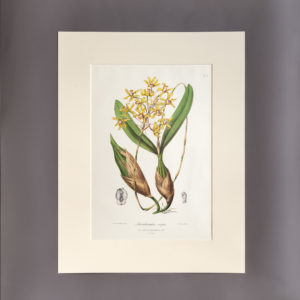
Sertum Orchidaceum by John Lindley 1838
£95 eachSertum Orchidaceum by John Lindley 1838
Spectacular large-scale prints of the most beautiful known Orchids selected, selected by John Lindley, perhaps the greatest early orchidologist, drawn by Sarah Anne Drake and lithographed by Maxime Gauci. Although John Lindley is now known as a botanist of wide accomplishments, the study of orchids had been an area of special interest to him from early in his career when he was employed by the orchid specialist William Cattley.£95 each -

Sertum Orchidaceum by John Lindley 1838
£95 eachSertum Orchidaceum by John Lindley 1838
Spectacular large-scale prints of the most beautiful known Orchids selected, selected by John Lindley, perhaps the greatest early orchidologist, drawn by Sarah Anne Drake and lithographed by Maxime Gauci. Although John Lindley is now known as a botanist of wide accomplishments, the study of orchids had been an area of special interest to him from early in his career when he was employed by the orchid specialist William Cattley.£95 each -

Sertum Orchidaceum by John Lindley 1838
£95 eachSertum Orchidaceum by John Lindley 1838
Spectacular large-scale prints of the most beautiful known Orchids selected, selected by John Lindley, perhaps the greatest early orchidologist, drawn by Sarah Anne Drake and lithographed by Maxime Gauci. Although John Lindley is now known as a botanist of wide accomplishments, the study of orchids had been an area of special interest to him from early in his career when he was employed by the orchid specialist William Cattley.£95 each -

Sertum Orchidaceum by John Lindley 1838
£95 eachSertum Orchidaceum by John Lindley 1838
Spectacular large-scale prints of the most beautiful known Orchids selected, selected by John Lindley, perhaps the greatest early orchidologist, drawn by Sarah Anne Drake and lithographed by Maxime Gauci. Although John Lindley is now known as a botanist of wide accomplishments, the study of orchids had been an area of special interest to him from early in his career when he was employed by the orchid specialist William Cattley.£95 each -

Sertum Orchidaceum by John Lindley 1838
£95 eachSertum Orchidaceum by John Lindley 1838
Spectacular large-scale prints of the most beautiful known Orchids selected, selected by John Lindley, perhaps the greatest early orchidologist, drawn by Sarah Anne Drake and lithographed by Maxime Gauci. Although John Lindley is now known as a botanist of wide accomplishments, the study of orchids had been an area of special interest to him from early in his career when he was employed by the orchid specialist William Cattley.£95 each -

Sertum Orchidaceum by John Lindley 1838
£95 eachSertum Orchidaceum by John Lindley 1838
Spectacular large-scale prints of the most beautiful known Orchids selected, selected by John Lindley, perhaps the greatest early orchidologist, drawn by Sarah Anne Drake and lithographed by Maxime Gauci. Although John Lindley is now known as a botanist of wide accomplishments, the study of orchids had been an area of special interest to him from early in his career when he was employed by the orchid specialist William Cattley.£95 each -

Sertum Orchidaceum by John Lindley 1838
£95 eachSertum Orchidaceum by John Lindley 1838
Spectacular large-scale prints of the most beautiful known Orchids selected, selected by John Lindley, perhaps the greatest early orchidologist, drawn by Sarah Anne Drake and lithographed by Maxime Gauci. Although John Lindley is now known as a botanist of wide accomplishments, the study of orchids had been an area of special interest to him from early in his career when he was employed by the orchid specialist William Cattley.£95 each -

Sertum Orchidaceum by John Lindley 1838
£95 eachSertum Orchidaceum by John Lindley 1838
Spectacular large-scale prints of the most beautiful known Orchids selected, selected by John Lindley, perhaps the greatest early orchidologist, drawn by Sarah Anne Drake and lithographed by Maxime Gauci. Although John Lindley is now known as a botanist of wide accomplishments, the study of orchids had been an area of special interest to him from early in his career when he was employed by the orchid specialist William Cattley.£95 each -

Sertum Orchidaceum by John Lindley 1838
£95 eachSertum Orchidaceum by John Lindley 1838
Spectacular large-scale prints of the most beautiful known Orchids selected, selected by John Lindley, perhaps the greatest early orchidologist, drawn by Sarah Anne Drake and lithographed by Maxime Gauci. Although John Lindley is now known as a botanist of wide accomplishments, the study of orchids had been an area of special interest to him from early in his career when he was employed by the orchid specialist William Cattley.£95 each -

Sertum Orchidaceum by John Lindley 1838
£95 eachSertum Orchidaceum by John Lindley 1838
Spectacular large-scale prints of the most beautiful known Orchids selected, selected by John Lindley, perhaps the greatest early orchidologist, drawn by Sarah Anne Drake and lithographed by Maxime Gauci. Although John Lindley is now known as a botanist of wide accomplishments, the study of orchids had been an area of special interest to him from early in his career when he was employed by the orchid specialist William Cattley.£95 each -

Sertum Orchidaceum by John Lindley 1838
£95 eachSertum Orchidaceum by John Lindley 1838
Spectacular large-scale prints of the most beautiful known Orchids selected, selected by John Lindley, perhaps the greatest early orchidologist, drawn by Sarah Anne Drake and lithographed by Maxime Gauci. Although John Lindley is now known as a botanist of wide accomplishments, the study of orchids had been an area of special interest to him from early in his career when he was employed by the orchid specialist William Cattley.£95 each -

Sertum Orchidaceum by John Lindley 1838
£95 eachSertum Orchidaceum by John Lindley 1838
Spectacular large-scale prints of the most beautiful known Orchids selected, selected by John Lindley, perhaps the greatest early orchidologist, drawn by Sarah Anne Drake and lithographed by Maxime Gauci. Although John Lindley is now known as a botanist of wide accomplishments, the study of orchids had been an area of special interest to him from early in his career when he was employed by the orchid specialist William Cattley.£95 each -

Sertum Orchidaceum by John Lindley 1838
£95 eachSertum Orchidaceum by John Lindley 1838
Spectacular large-scale prints of the most beautiful known Orchids selected, selected by John Lindley, perhaps the greatest early orchidologist, drawn by Sarah Anne Drake and lithographed by Maxime Gauci. Although John Lindley is now known as a botanist of wide accomplishments, the study of orchids had been an area of special interest to him from early in his career when he was employed by the orchid specialist William Cattley.£95 each
Featured Items
-

Henri Matisse, ‘The Last Works of Henri Matisse’
£900 eachHenri Matisse, ‘The Last Works of Henri Matisse’
From Verve Vol. IX No. 35/36 published by Tériade under the title 'The Last Works of Henri Matisse'£900 each -

Portraits Part I by Constantin Guys, Verve Vol 2 / No. 5-6.
£500Portraits Part I by Constantin Guys, Verve Vol 2 / No. 5-6.
The Verve Review was a purposefully luxurious. It ran from 1937 to 1960, but with only 38 editions available, due to the high degree of design and editorial work dedicated to each issue. Each edition contained unique lithographic prints, commissioned by the editor, and each cover a double-page lithograph elaborated by one of the artists contained within. It was the brainchild of its editor Stratis Eleftheriades, a Greek National who moved to Paris in the early thirties to take part in the growing Modernist movement, writing under the name of Teriade.£500 -

Head of a Girl by Paul Klee, Verve Vol 2 / No. 5-6.
£800Head of a Girl by Paul Klee, Verve Vol 2 / No. 5-6.
The Verve Review was a purposefully luxurious. It ran from 1937 to 1960, but with only 38 editions available, due to the high degree of design and editorial work dedicated to each issue. Each edition contained unique lithographic prints, commissioned by the editor, and each cover a double-page lithograph elaborated by one of the artists contained within. It was the brainchild of its editor Stratis Eleftheriades, a Greek National who moved to Paris in the early thirties to take part in the growing Modernist movement, writing under the name of Teriade.£800 -

Portrait Fragment by Pierre Bonnard, Verve Vol 2 / No. 5-6.
£600Portrait Fragment by Pierre Bonnard, Verve Vol 2 / No. 5-6.
The Verve Review was a purposefully luxurious. It ran from 1937 to 1960, but with only 38 editions available, due to the high degree of design and editorial work dedicated to each issue. Each edition contained unique lithographic prints, commissioned by the editor, and each cover a double-page lithograph elaborated by one of the artists contained within. It was the brainchild of its editor Stratis Eleftheriades, a Greek National who moved to Paris in the early thirties to take part in the growing Modernist movement, writing under the name of Teriade.£600
